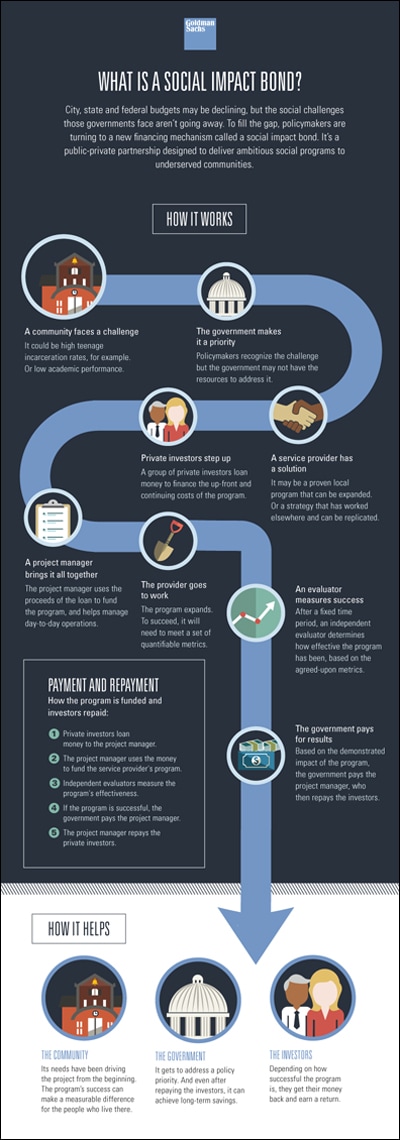First US Social Impact Bond Financed by Goldman Sachs
In 2012, in partnership with the City of New York and Bloomberg Philanthropies, Goldman Sachs finances the first social impact bond in the United States, a US$9.6 million loan aimed at reducing the rate of recidivism among adolescents incarcerated on Rikers Island.
The Goldman Sachs legacy of creating innovative solutions took on a dynamic new form with the firm’s pioneering work in the creation of the first “social impact bond” in the United States. This emerging financial instrument leverages private investment to support high-impact social programs.
In 2012, Goldman Sachs, along with Bloomberg Philanthropies, worked with nonprofits and the City of New York to structure a funding mechanism to reduce the re-incarceration rate among adolescents at New York’s Rikers Island prison through an intervention program called NYC Able Project for Incarcerated Youth delivering education, training and intensive counseling. The return of the bond would depend entirely on the effectiveness of the program it supported.
Goldman Sachs funded the project through a US$9.6 million loan through its Urban Investment Group (formed in 2001). Bloomberg Philanthropies provided a US$7.2 million grant to guarantee a portion of the loan, reducing lending risk. It would be repaid based on the actual and projected cost-savings realized by New York City as a result of the decrease in recidivism among youth on Rikers. An independent evaluator would determine whether the project achieved the targeted reductions in re-incarceration.
The program offered the potential to generate substantial long-term savings for the city and its taxpayers. If the recidivism rate dropped by 20 percent, New York City would save as much as US$20 million in incarceration costs after repaying the loan with a return. If the intervention wasn’t successful, the city would pay nothing. For investors, the greater the success of the program, the greater the return.
Goldman Sachs would receive its capital back only if the re-admission rate to prison was reduced by 10 percent or more. If the reduction exceeded 10 percent, the firm would receive a financial return consistent with typical community development lending, with a cap on that return.
The financing for the project was inspired by the social impact bond model first employed in Peterborough Prison in the United Kingdom. Also known as “pay for success bonds,” social impact bonds produce a double bottom line, delivering societal improvements as well as a potential return on capital for investors — with no upfront cost to taxpayers.
“We believe this investment paves the way for a new type of instrument that enables the public sector to leverage upfront funding from the private sector,” said then Goldman Sachs Chairman and CEO Lloyd Blankfein.


The program enabled an innovative public-private partnership that shifted risk away from taxpayers, demonstrated the feasibility of large-scale interventions within correctional facilities, provided extensive data for evaluating the project, and opened up a new pool of capital to fund similar initiatives. Although this intervention did not produce the anticipated results, the New York City program was designed to show how such instruments can be designed with clear goals, metrics, and risk/reward profiles that can draw investors.
After the pioneering 2012 financing of the New York juvenile recidivism program, 25 social impact bonds have been issued in the United States as of May 2019.
This article was originally published as part of a series commemorating the 150th anniversary of Goldman Sachs’ founding in 1869.
Our signature newsletter with insights and analysis from across the firm
By submitting this information, you agree that the information you are providing is subject to Goldman Sachs’ privacy policy and Terms of Use. You consent to receive our newletter via email.